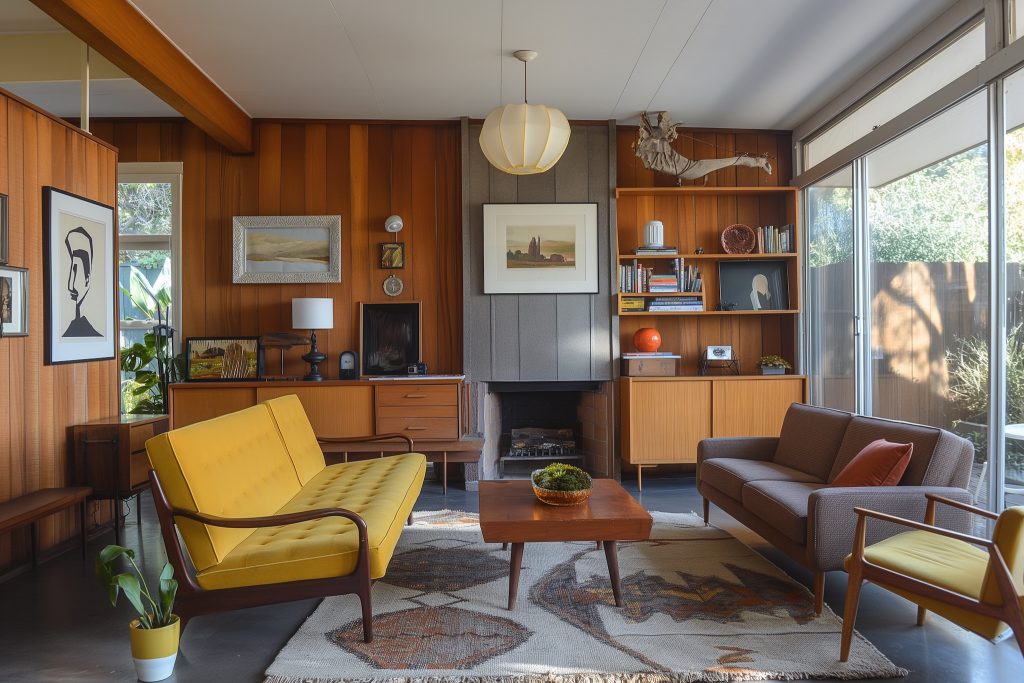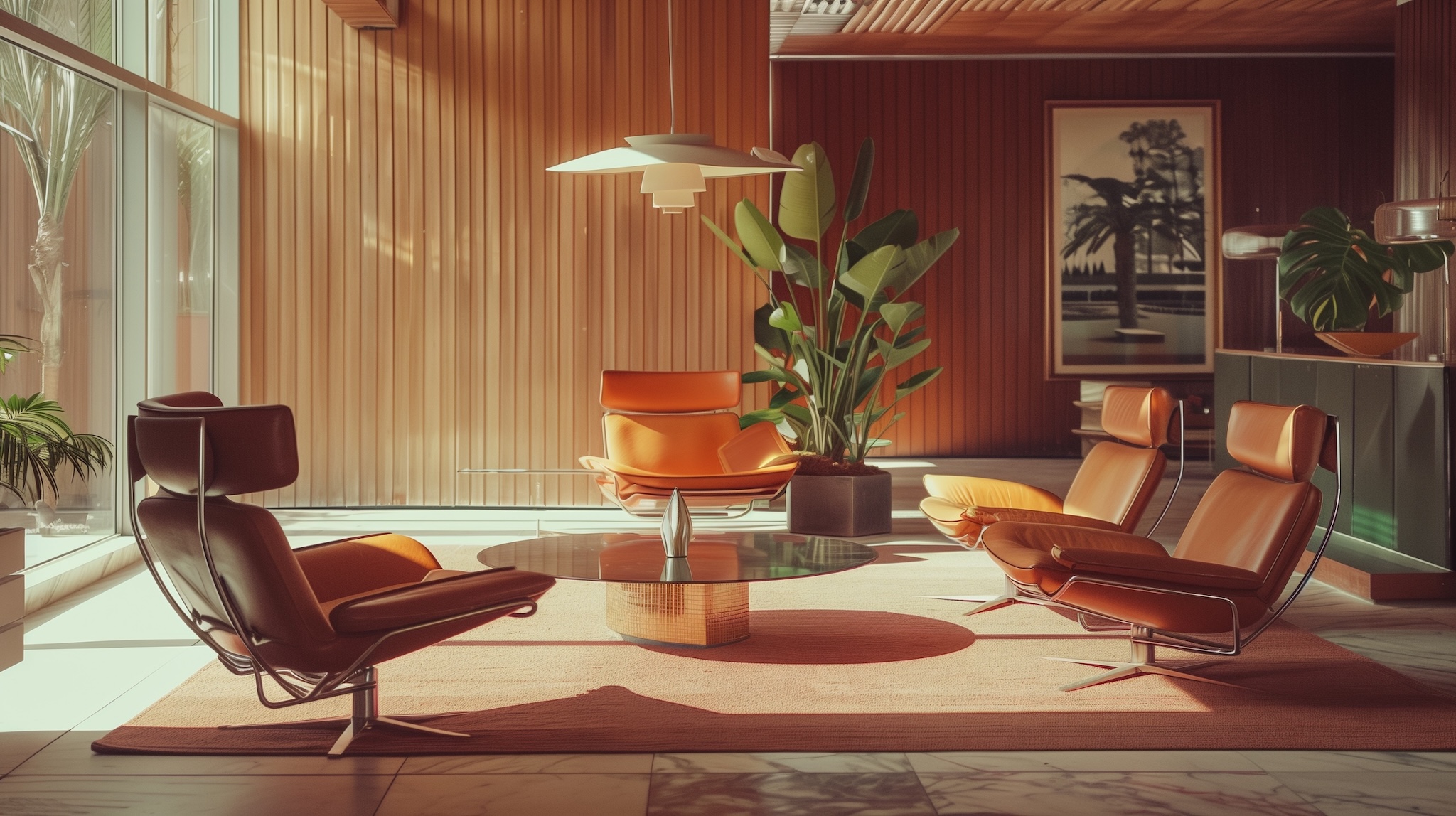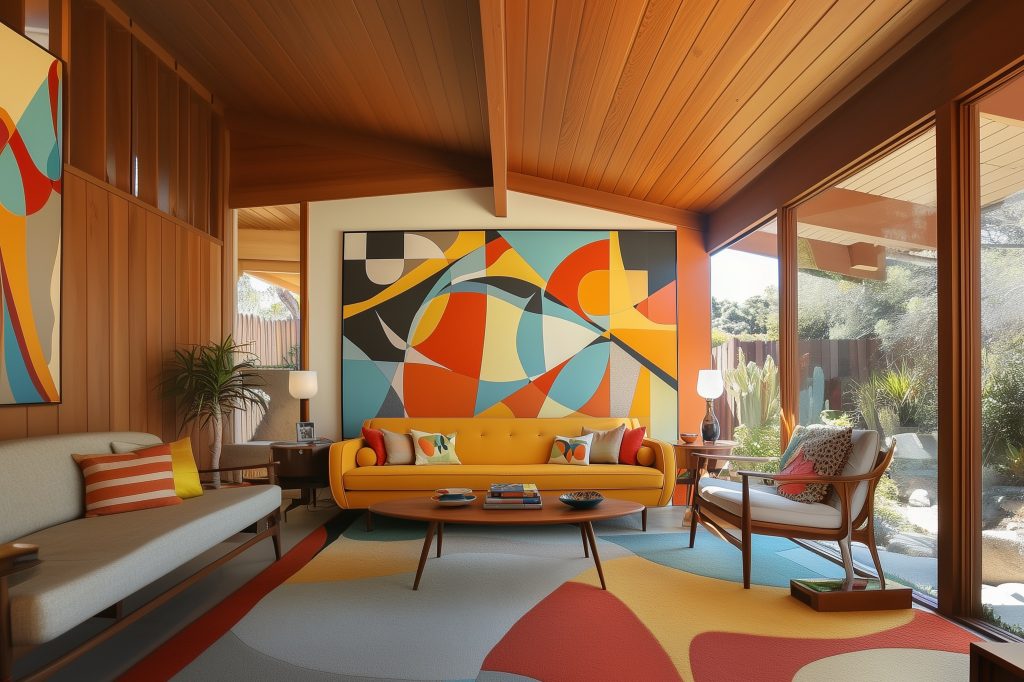Imagine walking into a home that exudes effortless style, where clean lines, organic shapes, and an emphasis on functionality create a sense of timeless elegance. Welcome to the world of mid-century modern design, a movement that emerged in the post-war era and continues to captivate us with its simplicity, sophistication, and enduring charm.
A Movement Born of Innovation and Necessity
In the aftermath of World War II, the world was changing rapidly. The post-war boom brought unprecedented prosperity, and with it, a growing middle class eager to furnish their new homes. Designers responded to this demand by creating furniture and decor that was not only stylish but also affordable and functional. The mid-century modern movement was born, marked by a willingness to experiment with new materials, technologies, and forms.
As the world slowly rebuilt itself, the design community was abuzz with creative energy. The mid-century modern movement, which spanned roughly from the mid-1940s to the late 1960s, was characterized by significant social, economic, and technological changes that greatly influenced the design world. The post-war boom led to a growing middle class, increased prosperity, and a surge in homeownership, creating a demand for functional, stylish, and affordable home furnishings.
The Roots of Mid-Century Modernism
To understand the mid-century modern movement, it’s essential to explore its roots. The Bauhaus, a German art school founded in 1919, emphasized the unity of art, craft, and technology, and sought to create functional, mass-producible designs. The school’s principles, such as simplicity, functionality, and the use of modern materials, would later be embraced by mid-century modern designers.
The International Style, which emerged in the 1920s and 1930s, also played a significant role in shaping mid-century modernism. This architectural movement favored simple, geometric forms, open floor plans, and the use of industrial materials like steel and glass. These elements would later be incorporated into mid-century modern architecture, creating a seamless connection between interior and exterior spaces.
The Pioneers of Mid-Century Modern
Meet the visionaries who shaped the movement: Charles and Ray Eames, the husband-and-wife duo who brought us the iconic Eames Lounge Chair; George Nelson, the design director who made mid-century modern accessible to the masses; Eero Saarinen, the Finnish-American architect who created futuristic masterpieces like the TWA Terminal; Florence Knoll, the designer and entrepreneur who popularized mid-century modern style; and Arne Jacobsen, the Danish architect who embodied the era’s minimalist ethos.
Charles and Ray Eames, perhaps the most iconic of the mid-century modern era, designed a wide range of products, from furniture to films. Their contributions include the famous Eames Lounge Chair and the molded plywood chair. The Eameses’ work was characterized by a commitment to experimentation, functionality, and affordability, making good design accessible to a wider audience.
George Nelson, as the design director for Herman Miller, was instrumental in bringing mid-century modern design to the masses. He created iconic pieces such as the Marshmallow Sofa, the Ball Clock, and the Coconut Chair, which exemplified the playful, organic forms of the era. Nelson’s influence extended beyond furniture, as he also made significant contributions to architecture and graphic design.
Eero Saarinen, a Finnish-American architect and designer, epitomized the sculptural, futuristic aesthetic of mid-century modernism. His notable designs include the Tulip Chair, the Womb Chair, and the TWA Terminal at JFK Airport. Saarinen’s designs often featured sweeping curves, innovative materials, and a sense of movement and dynamism.
Florence Knoll, as a designer and the head of Knoll Associates, played a significant role in popularizing mid-century modern design. She commissioned works from many of the era’s most prominent designers, including Eero Saarinen and Harry Bertoia, and created a coherent, modern aesthetic for the company. Knoll’s own designs, such as the Florence Knoll Sofa and the Parallel Bar Series, embodied the clean lines and functional elegance of the era.
Arne Jacobsen, a Danish architect and designer, was known for his minimalist, functional approach. His iconic designs include the Egg Chair, the Swan Chair, and the Series 7 Chair, all of which exemplify the organic, sculptural forms of mid-century modernism. Jacobsen’s work often featured innovative materials, such as bent plywood and molded plastic, and a focus on ergonomics and comfort.
Other notable figures of the mid-century modern movement include Harry Bertoia, Isamu Noguchi, Paul McCobb, and Jens Risom, each contributing their unique vision and groundbreaking designs to the era.
The Defining Characteristics of Mid-Century Modern
So, what makes mid-century modern design so unique? For starters, it’s all about simplicity and functionality. Clean lines, minimal ornamentation, and an emphasis on practicality defined the movement. Organic shapes, inspired by nature, added warmth and visual interest to spaces. Innovative materials and manufacturing techniques allowed designers to push the boundaries of form and function. And, of course, there’s the iconic use of bold colors and graphic patterns that added a touch of playfulness to the era’s designs.
Mid-century modern design often features curved, sculptural shapes inspired by nature, such as the iconic kidney-shaped coffee table or the biomorphic forms of Isamu Noguchi’s furniture and lighting designs. These organic forms added a sense of warmth and softness to the otherwise minimal and functional aesthetic of the era.
Designers of this era also embraced new materials, such as molded plywood, plastic, fiberglass, and wire mesh, which allowed for greater experimentation with form and function. These materials, combined with advancements in manufacturing techniques, enabled designers to create pieces that were both visually striking and mass-producible, making good design more accessible to a wider audience.
Integration with Nature and Indoor-Outdoor Living
Mid-century modern architecture often blurred the lines between indoor and outdoor spaces, with large windows, open floor plans, and a focus on bringing the outdoors in. This emphasis on connecting with nature can be seen in the work of architects like Richard Neutra and Pierre Koenig, whose glass-walled homes seamlessly integrated interior and exterior spaces. In furniture design, this connection to nature was reflected in the use of natural materials, such as wood and leather, and in the organic, biomorphic forms of many mid-century pieces.
Bold Colors and Graphic Patterns
While mid-century modern design is often associated with a neutral palette of earth tones and natural materials, the era also saw the use of bold, saturated colors and graphic patterns. Designers like Alexander Girard and Verner Panton incorporated vibrant hues and geometric patterns into their textile and furniture designs, adding a sense of playfulness and visual interest to the otherwise minimalist aesthetic.
The Lasting Impact of Mid-Century Modernism
The influence of mid-century modern design extends far beyond its original era, with its timeless appeal ensuring its enduring popularity. The movement’s emphasis on simplicity, functionality, and organic forms has had a lasting impact on contemporary design, influencing everything from furniture and decor to architecture and graphic design.
In recent years, there has been a resurgence of interest in mid-century modern design, with a new generation of design enthusiasts embracing the style. This renewed popularity has led to a thriving market for both vintage and reproduction mid-century pieces, as well as a plethora of contemporary designs that pay homage to the era.
The legacy of mid-century modernism can also be seen in its influence on subsequent design movements. The minimalist aesthetic that emerged in the 1960s and 1970s, for example, owes much to the simplicity and functionality of mid-century design. Similarly, the current trend towards sustainable and eco-friendly design echoes the mid-century emphasis on integrating nature and using innovative, environmentally conscious materials.
Furthermore, the mid-century modern movement’s focus on making good design accessible to a wider audience has had a lasting impact on the way we think about design. Today, many designers and brands continue to prioritize affordability and functionality, recognizing the importance of creating products that are both beautiful and practical.
Incorporating Mid-Century Modern Design in Contemporary Spaces
For those looking to incorporate mid-century modern design into their homes, there are countless ways to do so. One approach is to invest in iconic pieces from the era, such as an Eames Lounge Chair, a George Nelson Bubble Lamp, or a Florence Knoll Sofa. These statement pieces can serve as focal points in a room, anchoring the space and setting the tone for a mid-century inspired aesthetic.
Another option is to incorporate mid-century elements through smaller decor items, such as throw pillows, rugs, or wall art. Vintage-inspired prints, such as those offered by Mid Mod Style, can add a touch of retro charm to any room, while still complementing contemporary furnishings. Textiles with bold, graphic patterns or saturated colors can also help to evoke the mid-century modern spirit.
When incorporating mid-century modern design, it’s essential to strike a balance between vintage and contemporary elements. Pairing iconic mid-century pieces with modern furnishings can create a dynamic, eclectic space that feels both timeless and fresh. The key is to select pieces that share a common aesthetic, such as clean lines, organic forms, or a focus on functionality.
It’s also important to consider the overall layout and flow of the space. Mid-century modern design often favored open floor plans and a sense of continuity between rooms, so creating a cohesive, uncluttered space can help to capture the essence of the era. Incorporating natural elements, such as plants, wood accents, and plenty of natural light, can further enhance the mid-century modern aesthetic.
Conclusion
The history of mid-century modern design is a rich and fascinating story of innovation, creativity, and enduring style. From its post-war origins to its lasting influence on contemporary design, the movement has left an indelible mark on the world of architecture, furniture, and decor. By understanding the key figures, defining characteristics, and legacy of mid-century modernism, we can better appreciate its significance and draw inspiration from its timeless aesthetic.
Whether you’re a seasoned design enthusiast or simply drawn to the charm of retro style, incorporating mid-century modern elements into your home can create a space that is both stylish and functional. By embracing the simplicity, organic forms, bold colors, and innovative spirit of the era, you can create a living space that celebrates the enduring appeal of this iconic design movement.
As we continue to draw inspiration from the past and adapt it to our contemporary needs and sensibilities, the influence of mid-century modern design shows no signs of waning. Its timeless appeal, combined with its emphasis on functionality, accessibility, and connection to nature, ensures that it will continue to shape the way we live and design for generations to come.
So, whether you’re a die-hard mid-century enthusiast or simply looking to infuse your home with a touch of retro charm, the enduring legacy of this iconic era is sure to inspire and delight. From the sleek lines of a vintage Eames chair to the playful patterns of a retro-inspired rug, mid-century modern design is a timeless classic that will continue to captivate and inspire us for years to come.
The Future of Mid-Century Modern
As we look to the future, it’s clear that mid-century modern design will continue to play a significant role in shaping the way we live and design. With its emphasis on sustainability, functionality, and connection to nature, the movement’s principles are more relevant than ever.
As designers and homeowners, we can learn from the innovative spirit of mid-century modernism, embracing new materials, technologies, and forms while remaining true to the era’s timeless aesthetic. By doing so, we can create spaces that are not only beautiful and functional but also sustainable and environmentally conscious.
In the end, the legacy of mid-century modern design is a testament to the power of creativity, innovation, and style. As we continue to draw inspiration from this iconic era, we can create a brighter, more beautiful future – one that is deeply rooted in the principles of mid-century modernism.
Resources
For those looking to delve deeper into the world of mid-century modern design, there are numerous resources available. From vintage furniture dealers to contemporary design brands, here are a few of our favorites:
Vintage Furniture Dealers
Contemporary Design Brands
- West Elm
- Crate & Barrel
- Herman Miller
Mid-Century Modern Design Books
- “Mid-Century Modern: Furniture of the 1950s” by Cara Greenberg
- “The Mid-Century Modern Home” by Dominic Bradbury
- “Mid-Century Modern Design: A Complete Sourcebook” by Dominic Bradbury
Mid-Century Modern Design Museums
- The Museum of Modern Art (MoMA)
- The Whitney Museum of American Art
- The Eames House
Whether you’re a seasoned design enthusiast or simply starting to explore the world of mid-century modern design, we hope this article has provided a comprehensive and inspiring look at this iconic era. Happy designing!



